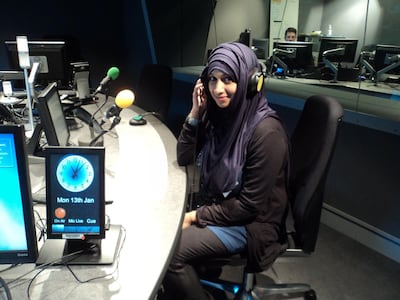In the UK, the media is often criticised for lacking inclusion and diversity, but Tasnim Nazeer is hoping to change that.
On July 16, just days before the London-born journalist turned 34, she made history, becoming the first hijab-wearing TV reporter in Scotland, after moving to Glasgow with her husband five years ago.
As a broadcast journalist for STV news, she broke barriers and has since used her success as a platform for promoting better diversity and inclusion in the media.
Really pleased to have done my first TV report as a freelance journo for @STVNews at Six highlighting the need for more bereavement support in Scotland. I don’t think a woman in hijab has ever anchored a news report in Scotland before. 1/3 pic.twitter.com/7hxqfniTEk
— Tasnim Nazeer (@TasnimNazeer1) July 30, 2020
Nazeer, from a family with Sri Lankan heritage, was only 15 when she reported on those worst-hit by the tsunami in 2004 for NewsLanka, a UK-based paper covering the South Asian country. After building her portfolio writing for several community papers, including Muslim News, she went on to work freelance radio shifts for BBC Radio 2. She later moved on to working as a television guest panellist on BBC Scotland and has written for news organisations including The Guardian, Forbes and The Independent, focusing on humanitarian issues and social justice.
Thanks STV for enabling me to break through the glass ceiling I felt I was under for so long. Representation is so important and glad to have been taken on based on skills and ability to do the job. 2/3
— Tasnim Nazeer (@TasnimNazeer1) July 30, 2020
Despite all her journalistic experience, it was still difficult for her to land a broadcast role. Several in the industry said she didn’t “have the right look” for television.
"People who networked with me in the media industry who would say, 'Look, you've got all the skills and all the potential, but unfortunately you just don't quite have the right look with the hijab on in Scotland'," she told The National.
“You don't really see black or Asian or other people of colour on Scottish TV, let alone people with the scarf. Then I was told that it really kind of hit home as to how am I going to get past this glass ceiling that's been imposed on me. If I've got the skills, then what's the problem?”
Although she could have progressed if she compromised her beliefs and identity, she refused to conform.
“My hijab is something I would never compromise. I’ve always had these morals and values and I wear the hijab out of my obedience to God and commitment to my faith. I felt like it wasn’t right for somebody to ask me to remove that because it would hinder my ability to do the job.”
She finally landed her first broadcast journalist role at STV in May this year. Despite initial concerns that she would not be able to move up the ladder, Nazeer said the channel was very supportive and did not once judge her on her identity.
Those facing challenges breaking into any industry because of their faith, race or culture, are often too afraid to speak out in case they are reprimanded or it scuppers their job prospects.
“Those people don't even know who to turn to for support,” Nazeer said.
“So when they had seen that I'd spoken out and seen challenges, I was inundated with messages with people saying 'this has happened to us', ‘we are still in a glass ceiling’, all those kinds of things.”
Although she was worried about negative reaction to her TV broadcasting debut, Nazeer has mostly received support. Since then, MPs, journalists and celebrities such as Lorraine presenter Ria Hebden have all come to the table to call for more media diversity.
But the fight to break the glass ceiling continues. Nazeer hopes to continue to do live broadcasting and is campaigning for more diversity in the British media.
It’s important that media outlets in Scotland have representation on screen that reflects the national portrait of the society we live in & bring in different stories & perspectives. 3/3
— Tasnim Nazeer (@TasnimNazeer1) July 30, 2020
“I’m really hoping to work with individuals within the media to highlight ways in which we can achieve better representation in actionable measures. It's all very well to have funding and investment in diversity and inclusion but if there're no actionable steps, we won’t see it reflected on screen.”





